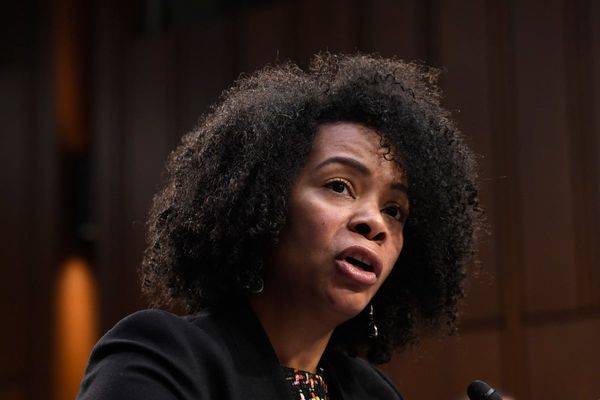ST. LOUIS — The back hardwood stairs of the historic Taille de Noyer, an antebellum home in Florissant, Missouri that started as a two-room log cabin for fur traders, tell many stories.
The stairs are worn and dipped in the middle, points out the foreword of a new book about slavery in north St. Louis County.
“Let us remember that some of the feet on those steps did not walk there by choice, that some of the hands on the handrail were being summoned by service,” writes Andrew Theising, the editor of “In the Walnut Grove: A Consideration of the People Enslaved in and Around Florissant, Missouri.”
The book tells the stories of many enslaved people and places around the home, one of the oldest in St. Louis County, now sandwiched between McCluer High School and its tennis courts. Taille de Noyer loosely translates to “Walnut Grove.” Some of the hewn walnut logs that make up its flooring joists would have been made with enslaved labor. (Historians prefer the use of the more humanizing term “enslaved people” over slaves.)
Not many details are known about slavery on the house and its property, though the land’s first owner, John Mullanphy, enslaved people. His children and descendants did as well.
Many of the book’s essays and chapters come from the newsletters of the Florissant Valley Historical Society. It operates the mansion, which has been closed because of the coronavirus.
Theising, a political science professor at Southern Illinois University-Edwardsville, is the treasurer of the historical society.
The society is working on an exhibit about enslaved people who lived on the property and in north St. Louis County, and is working on ways to tell a more complete history.
Take, for example, the home’s attic filled with a collection of historic wedding dresses.
Theising thought about the labor involved to wash the clothes — fetching the water, building the fire to heat the water, scrubbing the fabric, pressing it smooth.
“We think, oh, wouldn’t the person who wore this, wouldn’t she have looked beautiful? But it was a white woman who wore most of these clothes, I’m sure. And it was probably not a white woman who had to wash them.”
On a broader scale, Theising points out that any place made of brick in St. Louis before the Civil War was likely built with enslaved labor, either the buildings themselves or the people enslaved by brick makers. The history of slavery isn’t easily separated from the rest.
Carol Daniel, a journalist for KMOX radio, points out in the book’s forward that Black history is American history. The economic growth of the country or the landowners didn’t happen in a vacuum.
“My ancestors were property and were as much a part of the mechanism as the horse, and the wagon and the saw mill,” she said. “We were people, but we were a hammer. We were a saw.”
Theising was surprised to learn that north St. Louis County has historically had a larger African American population — in fact, there were more people enslaved in St. Ferdinand Township, which is basically north St. Louis County above Natural Bridge Road, than any other township in St. Louis County or ward of the city.
He theorizes that’s because the wealthier city founders moved north when they bought land, and enslaved people to work on it.
Take a drive or look at any map in north St. Louis County and you’ll see the names: Jennings is named after James Jennings, who brought 40 enslaved people with him from Virginia in 1839. Richard Graham owned an estate called Hazelwood, and he and his descendants were the largest slaveholders in the township, Theising writes.
He remembers coming across a list of enslaved people at Hazelwood during his research, and the list had first names written down along with their dollar value. The dollar value of “Old Bill” and “Old John?”
Zero.
“I feel emotional when I read that and just think about what was there, and we drive through Hazelwood all the time,” said Theising.
John Wright is a retired local school administrator who has written several books on north St. Louis County history. Theising drew from his work for the book.
Wright says it’s important to write down this history behind names and places because it shows presence. “With some people, if you didn’t see it in writing, it didn’t happen. If you tell them, they’ll say you’re lying.”
Wright remembers when white people were encouraged to move from the city to North County in the 1970s, and remembers seeing a white woman cry during a meeting about school desegregation. “She said, ‘I thought I could move in a place where I wouldn’t have to be with them,’” he said.
“They had no clue that African Americans also lived in North County many times before they did,” he said.
The book discusses North County’s history with desegregation, housing issues, and later civil rights movements, including the shooting of Michael Brown, which happened less than five miles from Taille de Noyer.
The historical society started exploring this history in 2019, after the New York Times started a series marking the 400th anniversary of British slavery in North America.
The Jesuits have been working to reach out to descendants of enslaved people who worked on St. Louis University, their church and their seminary at St. Stanislaus in Hazelwood. The St. Ferdinand shrine complex in Florissant, whose church turns 200 this month, is also exploring its history with enslaved labor.
Father Joseph Brown, a Jesuit, visited St. Stanislaus in the 1960s during his studies. He had no idea about the Jesuit slavery history until a classmate wrote his thesis on the subject and was heavily criticized then for it. Brown wrote a short meditation about his life for the book.
People need to read these stories to not only learn a complete history, but to learn about resilience and faith of these people, he said. Many retained their Catholic faith.
“That’s what makes the hope even stronger,” he said. “No matter what you have done to me, I am a child of God. You can call me anything you want or to do anything you want, but I know better. That’s the story.”







